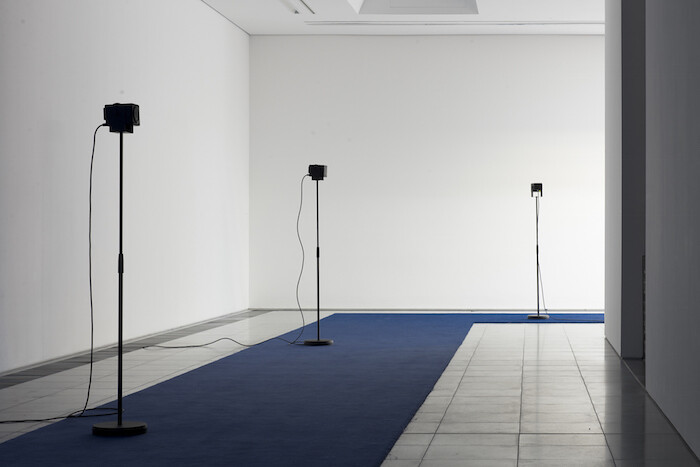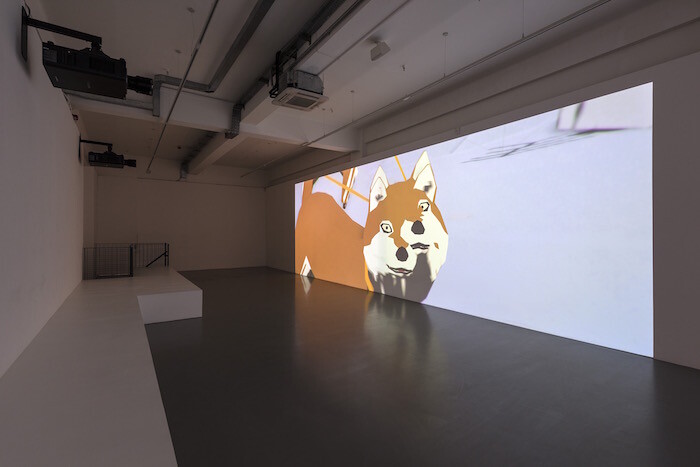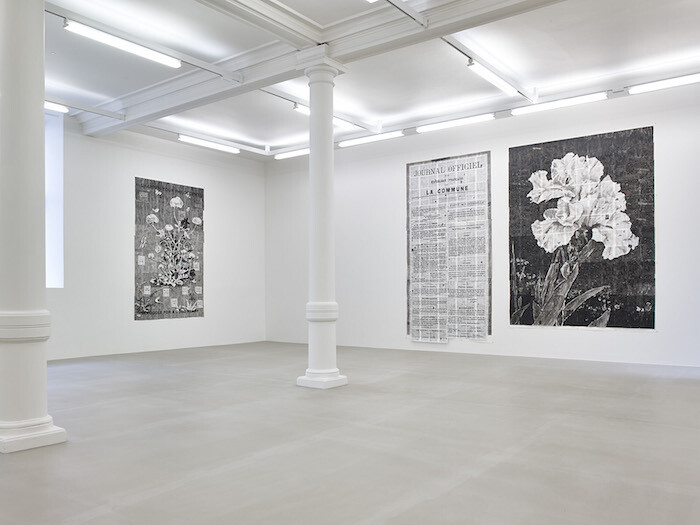In an art fair week, when it seems like everyone around is constantly discussing where they were, what they saw, and how it was, discourse is dependent on physical participation, on the encounter with art in a space, strengthening the primacy of the exhibition as a mode of experiencing artwork. While there is still a lot of thinking to be made about how display has historically shaped production and continues to do so, Frieze week in London is a great moment to assess whether there is something about the exhibition that makes it such a lasting form.
So why do we still go see exhibitions? Chisenhale Gallery is showing Jumana Manna’s A magical substance flows into me (2015), a 70-minute film screened five times a day. It is an exploration of traditional local music in Palestine/Israel, based on Manna’s research into the work of the German-Jewish ethnomusicologist Robert Lachmann (1892-1939) in Mandatory Palestine. Manna plays radio recordings made by Lachmann on an iPhone to the participants in her film, ranging from a young Jewish musician singing the Arabic songs her Moroccan grandmother taught her to a Palestinian flute maker who explains that traditional Palestinian music is more fashionable in the West Bank than in the Israeli territories. It’s a nuanced piece about place and tradition, and watching the film in the space with other people (as opposed to a screening program or on a laptop at home) brings to mind the fact that music is always a social construct.
Sound is used in a different way in Rachel Rose’s solo exhibition, “Palisades,” at the Serpentine Galleries. Rose, who also has work at the fair (she won this year’s Frieze Artist Award) exhibits two fantastic video works from 2014 in the vaults of the Sackler Gallery, immersed in a sound installation compiled from the soundtrack of one of the pieces, Palisades in Palisades. While the screenings are intimate and allow the viewer to watch the videos—Palisades about the history and memory of the landscape of the homonymous park in New York; A Minute Ago a shiver-inducing sequence of a hailstorm interspersed with images shot at Philip Johnson’s Glass House—in full, the sound installation feels like a requisite to fill the architecture, to make an all-encompassing presentation rather than a modest show of two videos, which could have easily spoken for themselves.
There was little experimentation with small, modest arrangements around town, with most galleries opting for immersive projects and large-scale installations. At Pilar Corrias, Ian Cheng presents a massive single-screen projection of a live simulation, Emissary Forks At Perfection (2015), the second part of a series of works that explore the history and the possible future of cognitive evolution. “Emissary Forks At Perfection” presents a foreign, futuristic, terrifying landscape inhabited by Shiba Inu dogs (yes, the ones from the memes) and accompanied by a vinyl wall text, a diagram simulating how the world has gotten to that point. To be introduced into this world by this fatalistic text and the animal we now associate with internet silliness is an alienating experience only enhanced by the grand, wall-sized presentation. At Fiona Banner’s solo at Frith Street Gallery, the video Phantom (SS16) (2015) portrays the artist’s recent publication, an illustrated version of Joseph Conrad’s masterpiece novel recounting the dread of colonialism Heart of Darkness (1899), carried by a drone in the wind. The projection slips beyond the wall to smear the image over the floor and furniture, as if the space cannot incorporate the work fully. It’s accompanied by Font (2015), a typeface project designed as an amalgamation of fonts Banner has used for sculptural and publication projects in the past, an attempt to create something new that can contain the old within it, it is legible while laden with history.
At Maureen Paley Gallery, Liam Gillick’s exhibition, “The Thought Style Meets the Thought Collective” presents a number of pieces that involve physical presence in the space, be it the viewer’s or the creator’s. A Broadcast from 1887 on the Subject of Our Time (1996) includes a radio transmitter emitting a text first published in 1888 that you need to kneel next to in order to hear clearly; the installation When Do We Need More Tractors? Five Plans (1999) seems like a collection of firewood, wall text, and a floor piece until you read the accompanying text, explaining the process of its creation, haunted by activity (“mix vodka and glitter,” “pour a liter of vodka on the floor”). Stuart Middleton built a maze at his “the gonks” show at Carlos/Ishikawa, which is reminiscent of a military barracks: a kind of tent spread across the gallery, it is made of white polycotton and metal frames and washed by light. Walking inside the tight (it is only about five and a half feet in height) space feels intimate and comfortable in a way that one wouldn’t imagine from the outside. There’s another maze-like construction at Robilant+Voena, showing “The Body and the Space 1959–1980,” a large selection of works by Italian Neo-Avant-Garde artist Gianni Colombo, including Topoesthesia – Three Contiguous Zones (Programmed Itinerary), an installation made of chords and light, creating an environment reminiscent of laser tag halls, only made in 1965–70. It’s astoundingly contemporary, which goes to teach us how much we neglect to see when constantly discussing “the new.”
Display plays a role in the way a viewer would access any of the works above, but many of the galleries in the city have pulled out the heavy guns in honor of the event that is Frieze London. At Marian Goodman, “More Sweetly Play the Dance,” a show of recent works from William Kentridge that are much the same as his previous projects. Alongside More Sweetly Play the Dance, a massive eight-screen video installation, is a series of paintings making reference to the events of the Paris Commune and the Cultural Revolution in China, which are then used as imagery in a new three-screen film installation, Notes Towards a Model Opera (2014–2015) alluding to the political dimension of the imagery without ever saying much about it or giving any context. Similarly flirting with the political but never offering substance is Oscar Murillo, who is showing footage from his hometown in Colombia at his “binary function” exhibition at David Zwirner (accompanied by many canvases, of course, and black paintings made with dirt reminiscent of the black flags he presented at the current Venice Biennale). While the video Meet me! Mr. Superman (2013-15) isn’t political—it’s a short depiction of a social situation, men meeting at a cafe—its inclusion in the upscale gallery, complete with dirty white plastic chairs for the viewer to sit on, reads as a naive (if not flat-out cynical) wink at inclusion of content from locations not often represented in Mayfair.
What Murillo’s presentation overlooks is that it’s okay (especially at an art-fair time of year) to show painting without pretending that it is political. At Wilkinson Gallery, Phoebe Unwin’s exhibition “Distant People and Self-Soothing Objects,” presents a series of grayscale paintings veering from traditional art-historical subjects, like a body in nature, to much more contemporary ones, such as a head with headphones on. The traditional, painterly technique (Indian ink on canvas or board) is contrasted by the fact that the works are reminiscent of early black-and-white photography. Or was my viewing of it conditioned by my exposure to technology? Phone (2015) nearly answers that question: it is almost abstract but the brushstrokes imitate the traces left by a greasy fingers on a glass screen.
The primacy of the event was broken by the least likely candidate: the Serpentine Galleries’ traditional marathon (this year on the subject of “transformation”) is back to its 24-hour version, only this time half of it was not performed at the space, but rather in a radio program online. At 2 a.m. Jumana Manna talked about urban and rural Palestinian music, and the way it was presented in her film, tying the virtual space with the physical space of her exhibition. A constantly updated blog completed this complex system of live events inhabit public space both at the gallery and on the internet.
And the exhibition? Well, the more things change, the more they stay the same. But that’s okay because we’re not done with the format just yet anyway. At Cubitt, Morgan Quaintance curated “Software, Hard Problem,” showing Cécile B. Evans’s archives from two artificial intelligence projects (Black Box (Server Sleep), 2015), a real-time simulation by Lawrence Lek (Gravity’s Folly, 2015), and paintings or drawings produced by computer algorithms coded by Manfred Mohr.1 Marked by a strong sense of considered curatorial authorship from Quaintance, who divided an already small show into three sections that pose enormous questions—“the problem of form,” “the problem of tool mastery,” and “the problem of consciousness”—it’s a great reflection of three smart and different considerations of showing work made for or by computers and the way they should (or could) be exhibited in a gallery space. Changes are coming, soon, even if slowly.
Morgan Quaintance is also a Contributing Editor at art-agenda.













